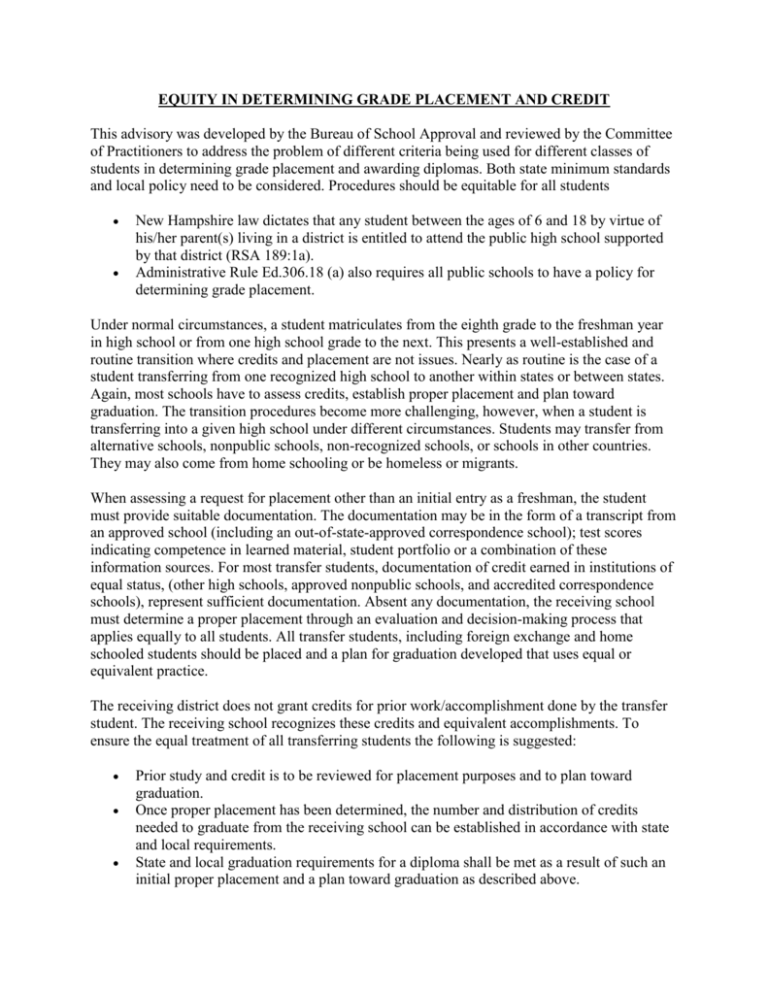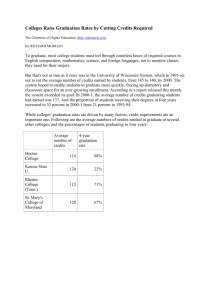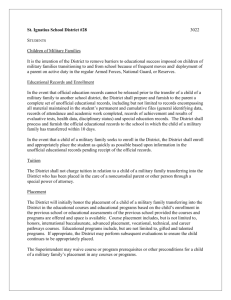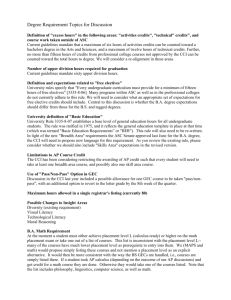EQUITY IN DETERMINING GRADE PLACEMENT AND CREDIT
advertisement

EQUITY IN DETERMINING GRADE PLACEMENT AND CREDIT This advisory was developed by the Bureau of School Approval and reviewed by the Committee of Practitioners to address the problem of different criteria being used for different classes of students in determining grade placement and awarding diplomas. Both state minimum standards and local policy need to be considered. Procedures should be equitable for all students New Hampshire law dictates that any student between the ages of 6 and 18 by virtue of his/her parent(s) living in a district is entitled to attend the public high school supported by that district (RSA 189:1a). Administrative Rule Ed.306.18 (a) also requires all public schools to have a policy for determining grade placement. Under normal circumstances, a student matriculates from the eighth grade to the freshman year in high school or from one high school grade to the next. This presents a well-established and routine transition where credits and placement are not issues. Nearly as routine is the case of a student transferring from one recognized high school to another within states or between states. Again, most schools have to assess credits, establish proper placement and plan toward graduation. The transition procedures become more challenging, however, when a student is transferring into a given high school under different circumstances. Students may transfer from alternative schools, nonpublic schools, non-recognized schools, or schools in other countries. They may also come from home schooling or be homeless or migrants. When assessing a request for placement other than an initial entry as a freshman, the student must provide suitable documentation. The documentation may be in the form of a transcript from an approved school (including an out-of-state-approved correspondence school); test scores indicating competence in learned material, student portfolio or a combination of these information sources. For most transfer students, documentation of credit earned in institutions of equal status, (other high schools, approved nonpublic schools, and accredited correspondence schools), represent sufficient documentation. Absent any documentation, the receiving school must determine a proper placement through an evaluation and decision-making process that applies equally to all students. All transfer students, including foreign exchange and home schooled students should be placed and a plan for graduation developed that uses equal or equivalent practice. The receiving district does not grant credits for prior work/accomplishment done by the transfer student. The receiving school recognizes these credits and equivalent accomplishments. To ensure the equal treatment of all transferring students the following is suggested: Prior study and credit is to be reviewed for placement purposes and to plan toward graduation. Once proper placement has been determined, the number and distribution of credits needed to graduate from the receiving school can be established in accordance with state and local requirements. State and local graduation requirements for a diploma shall be met as a result of such an initial proper placement and a plan toward graduation as described above. The graduation plan for any remaining credit and the fulfillment of state and local credit and distribution requirements should be planned with participation from the district, student and parent. Note: Prior work/accomplishment/credit is not to be evaluated with regard to a possible one-toone transfer of specific credits as though they were earned at the receiving school Definitions School: an organization whose primary purpose is the development of individual potential by means of a systematic method of instruction. Credit Earned: acknowledged course work, and/or transferred credits from approved schools to assist in grade placement. Credits to be Earned: coursework needed to complete state and local requirements for a diploma at the receiving school.







